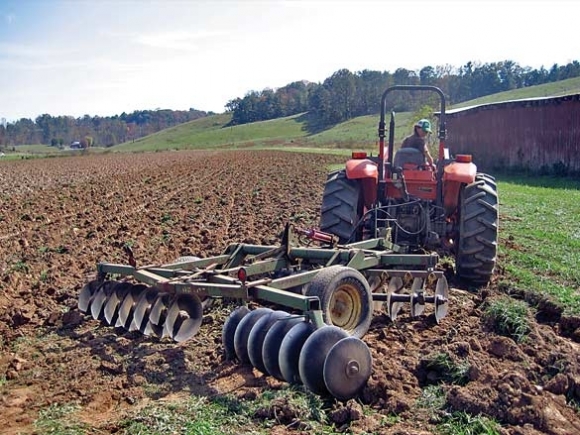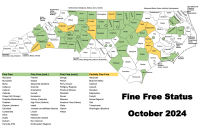Federal dollars fuel WNC farmland conservation: $8 million allocation is region’s largest ever

Land conservation groups across the region found something to celebrate this month when the U.S. Department of Agriculture announced an $8 million allocation for farmland conservation in Western North Carolina — a gargantuan number that the Southern Appalachian Highlands Conservancy calls “unprecedented.”
This type of funding, allocated through the Natural Resource Conservation Service’s Regional Conservation Partnership Plan under the Agricultural Conservation Easement Program, has been available in the past. But never before has the amount been so large or so specifically targeted to Western North Carolina.
“The funding just wasn’t high enough to cover really large mountain farms, so now we are able to access these farms that are in the 100- to 500-acre range that have a really big impact on the water quality flowing through them,” said Jessica Laggis, executive director of Blue Ridge Forever, the organization leading the conservation project.
A collective campaign of 12 land trusts, Asheville-based Blue Ridge Forever’s mission is to safeguard the land and water of the Southern Blue Ridge for future generations. Conservation easements — agreements in which the landowner retains ownership of the land while selling rights to future development on it — are one of the primary tools to achieve that end.
The funding is not a grant award. Rather, it’s an allocation to be dispensed by the NRCS. However, Blue Ridge Forever will have a seat the table when allocation decisions are made, and allocations will be granted in support of the overall goal to conserve farmland in the 25 western counties.
The $8 million is expected to cover conservation for 2,000 acres of farmland in the state’s 25 western counties. The funding comes from the 2014 Farm Bill and is part of the RCPP program. Laggis called the program a “really interesting” one that “emphasizes partnership and puts the creative impetus on the partners that are coming with a proposal.”
Related Items
Blue Ridge Forever’s project is called “Forever Farms: Easements at the Eminence.” The idea is to defend the region’s cultural heritage and food security by protecting working farmland while also keeping the mountain waters flowing through those acres clean for users downstream.
“There are nine different river basins in Western North Carolina because Western North Carolina encompasses both sides of the Eastern Continental Divide,” Laggis said. “These nine river basins flow throughout the Southeast. The headwaters here are influencing the drinking water for millions of people throughout the Southeast.”
In the past, however, it had been difficult for WNC to compete with other regions of the state and nation for farmland conservation dollars. Land is more expensive in the mountains than it is in the West’s vast agricultural regions, and the percentage of prime soils in the mountains is much lower than in the productive farmlands of Eastern North Carolina.
The region typically receives about $3 million for farmland conservation from the Agricultural Easement Conservation Program, Laggis said.
“But that has been for the entire state, and ACEP process prioritizes prime soils, which we have very few of in the mountains,” she said. “So it’s very hard for a large farm in the mountains, which is almost necessarily going to have some mountainside, to compete with a farm on the coast that might be almost 100 percent prime soils.”
By contrast, prime soils — the most productive soils for agriculture — make up only 3.6 percent of the landmass in WNC, Laggis said.
But she believes that low number should make protection of these farms more important, not less.
“If these soils are built upon, then we are really damaging our long-term local food security, and the problem facing those limited prime soils is that they always happen in the bottomlands that tend to be flatter,” Laggis said. “They also tend to lie along river valleys that have been inhabited for a long time, so they tend to have roads near them so they’re just really developable.”
For a farmer struggling through the risky year-to-year business of agriculture, selling off a parcel here and there for development can become an attractive option when financial hardship strikes. By purchasing conservation easements, land trusts can ensure that future development is not an option while giving farmers upfront financial compensation.
In the mountains, steep slopes mean that not every acre of farmland is used to grow crops. Tracts typically contain forested areas running up and down slopes where worthwhile agricultural production is impossible. In Blue Ridge Forever’s view, those unfarmed sections are as important to the value of the conservation easement as the fields themselves.
“It’s protecting not only cultural heritage and the water quality in the region, but also the biological diversity,” Laggis explained. “When you protect the farm that’s maybe 100 acres and 60 acres of it are pasture and cropland, there’s going to be another 40 acres up the mountains that are forested.”
Those forested acres often house mountain streams that are kept clean and free-running when future development is taken off the table. They can also house threatened and endangered species.
“The vast majority of habitats for endangered species is in private lands, so the best way to go about protecting that land is through voluntary easements,” Laggis said.
While land conservation organizations across the region are anticipating the positive effects of the new funding, the turnaround will take some time. The funds are allocated for use over a five-year period ending in 2022, and Laggis said they don’t expect to have any conservation projects closed out until 2018.
As to whether a repeat of the $8 million allocation might be possible, that’s an open-ended question. Officially, only one more round of the funding is available, Laggis said, though there is hope that the program will be included with the 2018 Farm Bill.
“We’re trying to gauge right now whether we could be competitive again given we won’t have had time by the time the deadline comes up to start our first project,” she said. “We’re hoping that we could still be viewed competitively because of the importance of the region, but as a coalition applying again, my concern is that the reviewers might prioritize new projects just because we haven’t proven the success of our currently proposed projects.”
The only guarantee is the $8 million that’s already been allocated, and that’s a hefty guarantee. However, there will still be plenty of farmland worthy of protection after the $8 million is gone, Laggis said, and area land trusts will continue their work regardless of the future of this particular funding stream.
“Whether or not this funding source is available to us again in the future, the land trusts in Western North Carolina are very dedicated to farmland preservation and they’ll continue working with other funding sources,” she said.
Get involved
Farmers interested in conserving their land can get their questions answered by contacting a local land trust to learn more about the process and potential reimbursement. Donations are also welcome to help leverage larger grant awards for land conservation.
Blue Ridge Forever’s member land trusts are listed at www.blueridgeforever.info/get-involved, along with their contact information and area of coverage.









